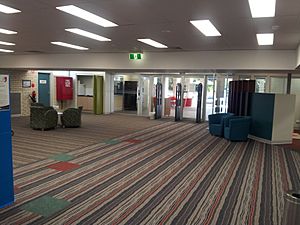City of Gold Coast facts for kids
Quick facts for kids City of Gold CoastQueensland |
|||||||||||||||
|---|---|---|---|---|---|---|---|---|---|---|---|---|---|---|---|

Location within South East Queensland
|
|||||||||||||||
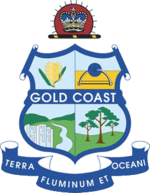
City of Gold Coast Coat of Arms
|
|||||||||||||||
| Population | 606,774 (2018) (2nd) | ||||||||||||||
| • Density | 454.85/km2 (1,178.1/sq mi) | ||||||||||||||
| Established | 1948 | ||||||||||||||
| Area | 1,334 km2 (515.1 sq mi) | ||||||||||||||
| Mayor | Tom Tate | ||||||||||||||
| Council seat | Surfers Paradise | ||||||||||||||
| Region | South East Queensland | ||||||||||||||
| State electorate(s) | Bonney, Broadwater, Burleigh, Coomera, Currumbin, Gaven, Mermaid Beach, Mudgeeraba, Southport, Surfers Paradise, Theodore | ||||||||||||||
| Federal Division(s) | Fadden, Forde, McPherson, Moncrieff, Wright | ||||||||||||||
 |
|||||||||||||||
| Website | City of Gold Coast | ||||||||||||||
|
|||||||||||||||
The City of Gold Coast is like the local government team for the famous Gold Coast area in Queensland, Australia. It also covers the areas around it. It's home to over 600,000 people. This makes it the second biggest local government area in Queensland, right after Brisbane.
The local council has more than 2,500 people working to keep things running smoothly. The City of Gold Coast was first set up in 1948. It has been in its current form since 2008. It sits right on the border with New South Wales. The Tweed Shire is just to its south.
Contents
How the Gold Coast City Council Started
Early Days of Local Government
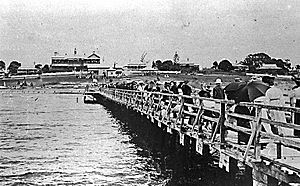
In the late 1870s, the government wanted local people to pay for services. These services included roads and other public works. They created a system of elected groups called divisional boards. These boards covered most of Queensland.
On 11 November 1879, 74 divisions were officially started. Four of these were in the Gold Coast region. They were Nerang, Coomera, Beenleigh and Waterford.
Southport grew as a main town and a holiday spot. It had hotels for visitors. People in Southport wanted their own board. They wanted their money to be spent on town improvements. So, the Southport Division was created on 14 July 1883. It was made from parts of Nerang and Coomera Divisions.
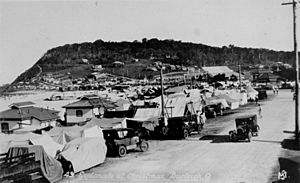
On 31 March 1903, these divisions became shires. A shire is a type of local government area. On 12 June 1914, the Town of Coolangatta was formed. It was made from part of the Shire of Nerang. Then, on 12 April 1918, Southport also became a town.
Growing into the Gold Coast
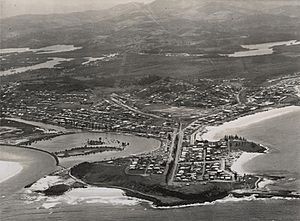
On 9 December 1948, a big change happened. The Town of South Coast was created. It joined the Town of Southport, the Town of Coolangatta, and parts of the Shire of Nerang. This created a long, narrow coastal area.
The old shires were removed. Most of their land became the new Shire of Albert. The rest went to the Shire of Beaudesert. These changes started on 10 June 1949.
On 23 October 1958, the Town of the South Coast changed its name. It became the Town of Gold Coast. Then, on 16 May 1959, it officially became the City of Gold Coast. This happened because it met the rules for being a city. Most of what we now call the Gold Coast was part of the Shire of Albert at that time.
Becoming a Bigger Region
In 1992, a group looked at local government borders. They suggested some changes. They thought Gold Coast City and Albert Shire should join. After much discussion, the Queensland Government decided to combine them.
On 16 December 1994, the Shire of Albert officially became part of Gold Coast City. This change happened at the local elections in 1995.
In 2007, another report suggested joining many local governments. It said the Beenleigh-Eagleby area should join Logan City. This was because people in that area had similar interests. It also made planning for the region easier. This change happened on 15 March 2008.
Special Places and Buildings
The Gold Coast has many places that are important to its history. These are called heritage-listed sites. You can find them in areas like:
- Currumbin
- Main Beach
- Pimpama
- Numinbah Valley
- South Stradbroke Island
- Southport
- Springbrook
- Surfers Paradise
- Tallebudgera
- Willow Vale
Gold Coast Suburbs
The Gold Coast is made up of many different suburbs and areas. You can find a full list of them here: List of Gold Coast suburbs.
Your Local Council: Gold Coast City Council
| Gold Coast City Council | |
|---|---|
| Leadership | |
|
Tom Tate, Independent LNP
|
|
|
Donna Gates, Independent
|
|
| Structure | |
| Seats | 15 elected representatives, including a mayor and 14 councillors |
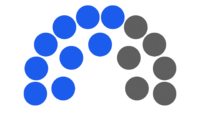 |
|
|
Political groups
|
|
| Elections | |
|
Last election
|
16 March 2024 |
The Gold Coast City Council is the group of people who make decisions for the city. It is split into 14 areas called divisions. Each division elects one councillor. These elections happen every four years.
The current Mayor is Tom Tate. He was first elected on 28 April 2012. He has been re-elected several times since then.
Who is on the Council Now?
The council elected in 2024 includes the Mayor and 14 councillors. They work together to manage the city.
| Ward | Councillor | Party | |
|---|---|---|---|
| Mayor | Tom Tate | Independent LNP | |
| Division 1 | Mark Hammel | Independent | |
| Division 2 | Naomi Fowler | Independent LNP | |
| Division 3 | Donna Gates | Independent | |
| Division 4 | Shelley Curtis | Independent LNP | |
| Division 5 | Peter Young | Independent | |
| Division 6 | Brooke Patterson | Independent LNP | |
| Division 7 | Joe Wilkinson | Independent LNP | |
| Division 8 | Bob La Castra | Independent LNP | |
| Division 9 | Glenn Tozer | Independent | |
| Division 10 | Darren Taylor | Independent LNP | |
| Division 11 | Dan Doran | Independent LNP | |
| Division 12 | Nick Marshall | Independent | |
| Division 13 | Josh Martin | Independent | |
| Division 14 | Gail O’Neill | Independent | |
Past Councillors
Here is a list of councillors from recent years:
| Year | Div 1 | Div 2 | Div 3 | Div 4 | Div 5 | Div 6 | Div 7 | Div 8 | Div 9 | Div 10 | Div 11 | Div 12 | Div 13 | Div 14 | ||||||||||||||
|---|---|---|---|---|---|---|---|---|---|---|---|---|---|---|---|---|---|---|---|---|---|---|---|---|---|---|---|---|
| Councillor | Councillor | Councillor | Councillor | Councillor | Councillor | Councillor | Councillor | Councillor | Councillor | Councillor | Councillor | Councillor | Councillor | |||||||||||||||
| 2016 | Donna Gates (Ind.) | William Owen Jones (Ind. LNP) | Cameron Caldwell (Ind. LNP) | Kristyn Boulton (Ind.) | Peter Young (Ind.) | Dawn Crichlow (Ind.) | Gary Baildon (Ind.) | Bob La Castra (Ind. LNP) | Glenn Tozer (Ind. LNP/Ind.) | Paul Taylor (Ind. LNP) | Hermann Vorster (Ind. LNP) | Pauline Young (Ind.) | Daphne McDonald (Ind.) | Gail O'Neill (Ind.) | ||||||||||||||
| 2020 | Mark Hammel (Ind.) | Donna Gates (Ind.) | Cameron Caldwell (Ind. LNP) | Brooke Patterson (Ind. LNP) | Ryan Bayldon-Lumsden (Ind. LNP) | Darren Taylor (Ind. LNP) | ||||||||||||||||||||||
| 2020 | ||||||||||||||||||||||||||||
| 2024 | Naomi Fowler (Ind. LNP) | Shelley Curtis (Ind. LNP) | Joe Wilkinson (Ind. LNP) | Dan Doran (Ind. LNP) | Nick Marshall (Ind.) | Josh Martin (Ind.) | ||||||||||||||||||||||
City Population Over Time

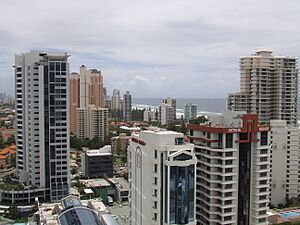
Here's how the population of the Gold Coast and Albert areas has grown over the years:
| Year | Population (Gold Coast) |
Annual growth (%) |
Population (Albert) |
Annual growth (%) |
|---|---|---|---|---|
| 1933 | 6,046 | N/A | ||
| 1947 | 13,888 | 6.12 | ||
| 1954 | 19,807 | 5.20 | ||
| 1961 | 33,716 | 7.90 | ||
| 1966 | 49,481 | 7.97 | 6,437 | N/A |
| 1971 | 66,697 | 6.15 | 10,165 | 9.57 |
| 1976 | 87,510 | 5.58 | 24,268 | 19.01 |
| 1981 | 117,824 | 6.13 | 54,870 | 17.72 |
| 1986 | 130,304 | 2.03 | 92,766 | 11.07 |
| 1991 | 157,857 | 3.91 | 143,697 | 9.15 |
| Year | Population | Annual growth (%) |
|---|---|---|
| 1991 | 301,554 | 6.21 |
| 1996 | 375,175 | 4.47 |
| 2001 | 441,736 | 3.32 |
| 2006 | 507,876 | 2.83 |
| 2011 | 494,501 | Beenleigh left in deamalgamation |
| 2016 | 551,721 | 2.49 |
Libraries for Everyone
The first public library on the Gold Coast opened in Southport in 1958. Before that, people used private libraries or "School of arts" buildings. These places helped people read and learn.
Today, the City of Gold Coast has 12 libraries. They are located in many suburbs like Broadbeach, Burleigh Heads, and Southport. There's also a special library for people with special needs. It is inside the Nerang Library.
The Southport Library has a Local Studies Library. This library focuses on the history of the Gold Coast. The council also has a mobile library service. This means a library on wheels visits smaller communities.
In 2018, the mobile library visited many places. These included Alberton, Ashmore, and Jacobs Well. The Gold Coast City Library is part of a group of public libraries in Queensland.
Important City Projects
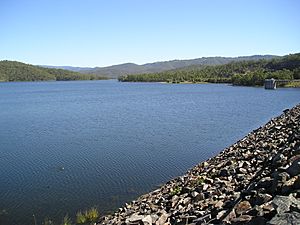
The City of Gold Coast works on many important projects. These projects help the city grow and improve. Some of these include:
- Gold Coast University Hospital - a big hospital for the community.
- Tugun Desalination Plant - a plant that turns seawater into drinking water.
- Raising of Hinze Dam - making a dam bigger to hold more water.
- Southport Broadwater Parklands - a large park area by the water.
- Gold Coast Rapid Transit System - a public transport system, like a tram.
- Gold Coast Ferry Service - a boat service for getting around.
- Gold Coast Regional Botanic Gardens - a beautiful garden for plants and nature.
- Evandale Cultural Precinct - a cultural area with the Home of The Arts centre. It also has a bridge to Chevron Island.
- Mermaid Waters Library - a new library for the community.
- Gold Coast Shoreline Management Plan - a plan to protect the coastline.
People Who Work for the City
Many notable people have worked for the City of Gold Coast.
- Guillermo Capati worked for the city from 1994 to 2017. He managed the city's water and wastewater. He also planned for future water needs. He received an award for his great work in water management.
- Ryan Bayldon-Lumsden was elected as a councillor in 2020. He was 27, making him the youngest person elected to that role. Before politics, he was a teacher. He also received an award for his community work.
Gold Coast's Global Friends
The City of Gold Coast has special relationships with other cities around the world. These are called Sister City Agreements or Other Partnerships. They help build friendships and share ideas.
Sister City Agreements
 Beihai, China
Beihai, China Da Nang, Vietnam (Friendship agreement)
Da Nang, Vietnam (Friendship agreement) Zhuhai, China
Zhuhai, China Tainan, Taiwan
Tainan, Taiwan Taipei, Taiwan
Taipei, Taiwan Dubai, United Arab Emirates
Dubai, United Arab Emirates Fort Lauderdale, Florida, United States
Fort Lauderdale, Florida, United States Takasu, Japan
Takasu, Japan Nouméa, New Caledonia
Nouméa, New Caledonia Netanya, Israel
Netanya, Israel Chengdu, China
Chengdu, China Kanagawa Prefecture, Japan (Friendship Agreement)
Kanagawa Prefecture, Japan (Friendship Agreement)
Other Partnerships


